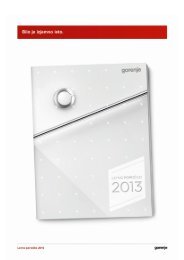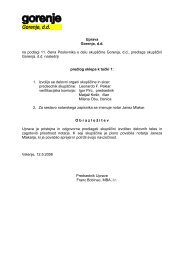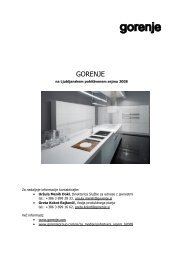ANNUAL REPORT 2008 - Gorenje Group
ANNUAL REPORT 2008 - Gorenje Group
ANNUAL REPORT 2008 - Gorenje Group
You also want an ePaper? Increase the reach of your titles
YUMPU automatically turns print PDFs into web optimized ePapers that Google loves.
143<br />
(b) Financial instruments<br />
(i) Non-derivative financial instruments<br />
Non-derivative financial instruments comprise investments in equity and debt securities, trade receivables,<br />
cash and cash equivalents, loans and borrowings, and trade and other payables.<br />
Non-derivative financial instruments are recognised initially at fair value. Subsequent to initial recognition<br />
non-derivative financial instruments are measured as described below.<br />
Attributable transaction costs are recognised in profit or loss. The exception are investments in equity,<br />
where the cost of financial instruments is increased by transaction costs.<br />
A financial instrument is recognised if the Company becomes a party to the contractual provisions<br />
of the instrument. Financial assets are derecognised if the Company’s contractual rights to the cash<br />
flows from the financial assets expire or if the Company transfers the financial asset to another party<br />
without retaining control or substantially all risks and rewards of the asset. Regular way purchases<br />
and sales of financial assets are accounted for at trade date, i.e. the date that the Company commits<br />
itself to purchase or sell the asset. Financial liabilities are derecognised if the Company’s obligations<br />
specified in the contract expire or are discharged or cancelled.<br />
Cash and cash equivalents comprise cash in hand and call deposits. Bank overdrafts that are repayable<br />
on demand and form an integral part of the Company’s cash management are included as a<br />
component of cash and cash equivalents for the purpose of the statement of cash flows.<br />
Accounting for finance income and expense is discussed in note 3(o).<br />
Available-for-sale financial assets<br />
Company’s investments in equity securities and certain debt securities are classified as available-forsale<br />
financial assets. Subsequent to initial recognition, they are measured at fair value and changes<br />
therein, other than impairment losses (see note 3(i)(i)), and foreign exchange gains and losses on<br />
available-for-sale monetary items (see note 3(b)(i)), are recognised directly in equity. When an investment<br />
is derecognised, the cumulative gain or loss in equity is transferred to profit or loss.<br />
Available-for-sale financial assets also include assets that could not be measured at fair value. The<br />
shares of these companies are not listed. They are measured on the basis of available data on the<br />
latest market transactions.<br />
Other<br />
Other non-derivative financial instruments are measured at amortised cost using the effective interest<br />
method, less any impairment losses.<br />
(ii) Derivative financial instruments<br />
The Company holds derivative financial instruments to hedge its foreign currency and interest rate<br />
risk exposures. Embedded derivatives are separated from the host contract and accounted for<br />
separately if the economic characteristics and risks of the host contract and the embedded derivative<br />
are not closely related, a separate instrument with the same terms as the embedded derivative<br />
would meet the definition of a derivative, and the combined instrument is not measured at fair<br />
value through profit or loss.<br />
Derivatives are recognised initially at fair value; attributable transaction costs are recognised in<br />
profit or loss when incurred. Subsequent to initial recognition, derivatives are measured at fair value,<br />
and changes therein are accounted for as described below.

















